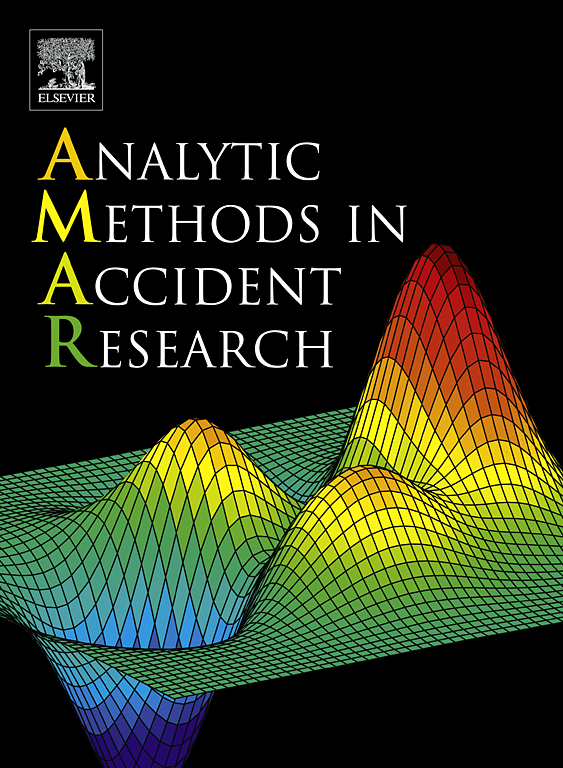影响与酒精相关的两车碰撞严重程度的决定因素:多变量贝叶斯分层随机参数相关结果Logit模型
IF 12.6
1区 工程技术
Q1 PUBLIC, ENVIRONMENTAL & OCCUPATIONAL HEALTH
引用次数: 0
摘要
由于与酒精有关的驾驶与交通事故的发生概率和所造成伤害的严重程度密切相关,尤其是两车之间的交通事故,因此与酒精有关的驾驶仍然是一个令人严重关切的问题。为了研究影响与酒精相关的两车碰撞严重程度的决定因素,采用的基础框架是多项式对数模型。同时,通过纳入个体案例和车辆水平的随机截距以适应未观察到的异质性,以及协方差矩阵以强调相关结果,提出了一个多变量分层随机参数相关结果 logit 模型。此外,为了进一步探索解释变量潜在的时间不稳定性,还在模型中引入了每年指标的随机斜率。研究使用了美国全州综合交通记录系统(SWITRS)数据库中从 2016 年 1 月 1 日到 2021 年 12 月 31 日的碰撞数据。研究了三个碰撞伤害严重程度类别,包括重伤、轻伤和无伤,并将与驾驶员、车辆、道路、环境、碰撞和时间相关的特征作为解释变量。模型结果凸显了显著的异质性,在轻伤和重伤的总方差中,每个案例和车辆分别占 56.9% 和 50.8%。此外,在案例层面上,轻伤和重伤结果之间存在明显的负相关。在潜在的时间不稳定性方面,我们提供了每年(2016-2019 年)的参数估计值,并确定了非交叉路口碰撞、侧面碰撞和正面碰撞、多云天气条件以及饮酒但未受影响的驾驶员等指标的显著不稳定性。考虑到 COVID-19 大流行的影响,我们将事故时间分为 COVID 前和 COVID 期间,对这两个时期的参数估计值进行建模。这一分析表明,受大流行病影响的几个因素存在明显的不稳定性。此外,与一般的两车碰撞事故或与酒精有关的碰撞事故相比,解释变量的估计结果出现了值得注意的差异,从而提供了有价值的见解。例如,饮酒但未受酒精影响的驾驶员受重伤的可能性较小,但受轻伤的可能性却增加了。这些发现强调了对酒精受损的两车碰撞事故中受伤严重程度的决定因素以及这些因素的时间不稳定性进行彻底调查的重要性。它们对有效的交通安全管理和制定禁止性对策具有重要意义。本文章由计算机程序翻译,如有差异,请以英文原文为准。
Determinants influencing alcohol-related two-vehicle crash severity: A multivariate Bayesian hierarchical random parameters correlated outcomes logit model
Alcohol-related driving remains a significant concern due to its profound association with the likelihood of traffic crashes and the severity of resulting injuries, especially between two vehicles. To investigate the determinants influencing the alcohol-related two-vehicle crash severity, a foundational framework employed was a multinomial logit model. Meanwhile, by incorporating random intercept from individual case and vehicle levels to accommodate unobserved heterogeneity, and covariance matrices to underscore correlated outcomes, a multivariate hierarchical random parameters correlated outcomes logit model was proposed. Additionally, to further explore the potential temporal instability of explanatory variables, a random slope from a per-year indicator was introduced into the model. Crash data from the US Statewide Integrated Traffic Records System (SWITRS) database spanning from January 1, 2016, to December 31, 2021, was used. Three crash injury severity categories were examined, encompassing severe injury, minor injury, and no injury, with characteristics related to the driver, vehicle, road, environment, crash, and time serving as explanatory variables. The model results highlighted significant heterogeneity, with each case and vehicle accounting for 56.9% of the total variance for minor injuries and 50.8% for severe injuries. Furthermore, a significant negative correlation was explicitly exhibited between minor injury and severe injury outcomes at the case level. In terms of potential temporal instability, we provided per-year (2016–2019) parameter estimates and identified significant instability for indicators such as non-intersection, broadside and head-on collisions, cloudy weather conditions, and drivers who had been drinking but were not under the influence. Considering the impact of the COVID-19 pandemic, we divided the accident time into pre-COVID and during-COVID periods, modeling parameter estimates for both periods. This analysis revealed significant instability in several factors influenced by the pandemic. Additionally, noteworthy disparities in the estimated results of explanatory variables emerged in comparison to those general two-vehicle crashes or alcohol-related crashes, providing valuable insights. For instance, drivers who had been drinking but were not under the influence were less likely to sustain severe injuries, but the probability of minor injuries increased. These findings underscore the significance of thorough investigations into the determinants of injury severity in alcohol-impaired two-vehicle crash severity, along with the temporal instability of such factors. They hold important implications for effective traffic safety management and the formulation of prohibitive countermeasures.
求助全文
通过发布文献求助,成功后即可免费获取论文全文。
去求助
来源期刊

Analytic Methods in Accident Research
Multiple-
CiteScore
22.10
自引率
34.10%
发文量
35
审稿时长
24 days
期刊介绍:
Analytic Methods in Accident Research is a journal that publishes articles related to the development and application of advanced statistical and econometric methods in studying vehicle crashes and other accidents. The journal aims to demonstrate how these innovative approaches can provide new insights into the factors influencing the occurrence and severity of accidents, thereby offering guidance for implementing appropriate preventive measures. While the journal primarily focuses on the analytic approach, it also accepts articles covering various aspects of transportation safety (such as road, pedestrian, air, rail, and water safety), construction safety, and other areas where human behavior, machine failures, or system failures lead to property damage or bodily harm.
 求助内容:
求助内容: 应助结果提醒方式:
应助结果提醒方式:


